An easy landscape maintenance checklist is the key to cultivating a thriving, low-maintenance garden that saves you time and resources. That way, you can travel more and have the free time to just enjoy the beauty of your gardens.
Follow these 7 easy steps with expert tips and strategies to design a garden that is both beautiful and easy to care for. Continue reading to discover how you can enjoy a lush, sustainable garden with minimal effort.

CONTENTS—In this article, you will discover a perfect landscape maintenance checklist for creating a low-budget and eco-friendly garden, including:
The Ultimate Guide to Creating a Low-Maintenance Garden
As gardeners and travelers become more conscious about their environmental impact, sustainable practices top their priority list.
Traditional gardening methods often involve high water usage, chemical pesticides and fertilizers, and frequent maintenance. So, creating a low-maintenance garden is not only beneficial for the environment but also saves you time, money, and energy. This is ideal if you love to travel, too.
Whether you have a small balcony or a large backyard, this 7-step landscape maintenance checklist will help you create a low-maintenance garden that thrives when you’re home or away.
1. Rely on Perennial Plants
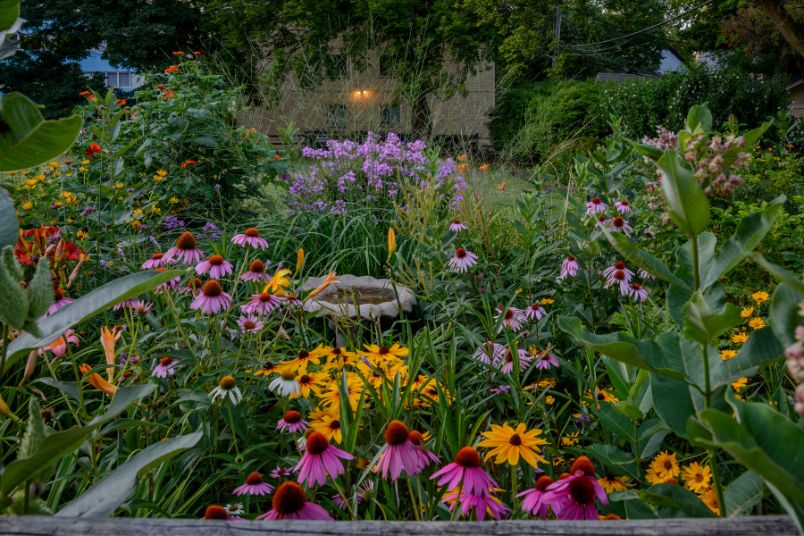
Perennial plants are the backbone of a low-maintenance garden. They return year after year with little effort required on your part as the gardener.
Unlike annuals, which need to be replanted each season, perennials establish a strong root system that helps them withstand drought and other environmental challenges. When the time is right, they’ll reliably emerge from the ground each year.
By choosing perennials suited to your climate and soil conditions, you’ll create a garden that grows in beauty and vibrancy each year without needing to be replanted often or needing extensive care.
In addition to being hardy and self-sufficient, you’ll discover perennials in a variety of textures, colors, and blooming cycles. This allows you to design a landscape that changes and evolves throughout the seasons.
Plant a mix of early, mid-season, and late-blooming perennials to create a visually appealing sanctuary throughout the growing season. Aside from some deadheading and occasional division, they’ll need little intervention on your part.
Better yet, perennials generally multiply, rewarding you with a steady supply of new plants for your garden habit.
2. Choose Native Plants
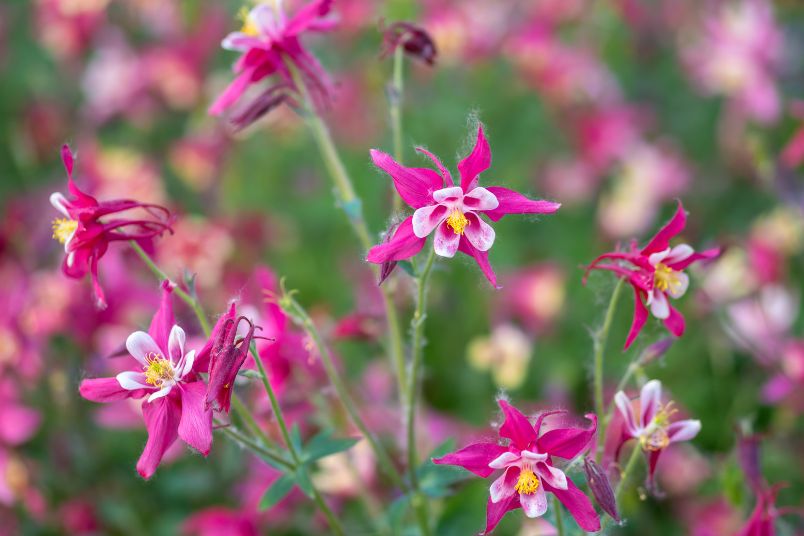
Shown: Columbine (Aquilegia vulgaris)
Another way to create a low-maintenance garden is to select native plants—those naturally found in your region. It’s an easy way to support a more sustainable and low-maintenance garden.
With a plant finder tool, you can easily discover which plants will thrive in your area.
Not only are native plants well-adapted to your local climate and soil conditions, but compared to their non-native counterparts, they also require:
- Less water
- Fewer, if any, pesticides
- Less fertilizer
Plus, native plants provide important habitats for local wildlife, creating a resilient and vibrant ecosystem. Incorporating native plants into your garden attracts beneficial wildlife, like pollinators and birds, further contributing to biodiversity.
When you opt for native plants in your garden, it minimizes the need for chemical interventions and reduces the overall effort and resources needed to maintain your garden.
That makes it a win-win!
3. Embrace Natural Mulch

Applying mulch is a simple yet effective way to reduce your garden maintenance.
Mulch helps retain soil moisture, which means you won’t need to water your garden as much. It also suppresses weeds by blocking sunlight from reaching the soil surface, preventing weed germination and growth.
Choose organic mulches, such as:
- Wood chips (preferably dye-free)
- Buckwheat hulls
- Straw (not hay, which often has seeds)
- Pine needles
- Shredded Leaf litter
By mulching your garden beds, you can add essential nutrients back into the soil. That’s because as the mulch decomposes, it will enhance your garden’s health.
The key is to apply a 2-3 inch layer of mulch, making sure it’s not too thick to impact air and water flow but sufficient to provide its intended benefits.
In addition to its practical benefits, mulch can improve your garden’s aesthetic appeal, too. It provides a clean and uniform look that can highlight the beauty of your plants. This is essential if you want to keep your gardens from looking unkempt.
And when you mulch around trees, shrubs, and flower beds, you’ll create a visually cohesive landscape that is as attractive as it is functional.
4. Consider Drip Irrigation
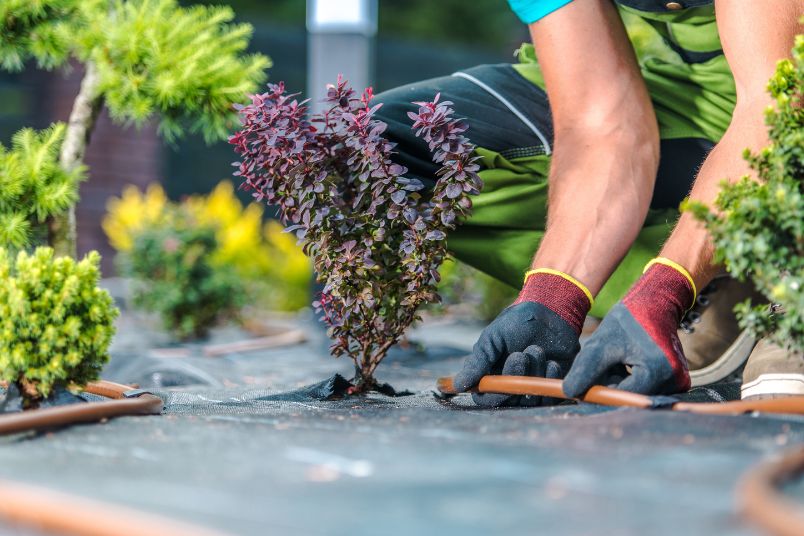
Traditional watering methods, such as sprinklers and hand-watering, can often be time-consuming and wasteful. Plus, if you’re away, you don’t want your darlings to die of thirst!
Drip irrigation, on the other hand, is a highly efficient way to water your garden with minimal effort. This method is better than overhead watering because it reduces evaporation.
Instead, a drip irrigation system delivers water directly to your plantings’ roots. Your plants will receive the right amount of water, and you’ll avoid unnecessarily watering the rest of the garden bed.
Furthermore, you can use timers to automate and control your drip irrigation systems, completely eliminating the need for watering by hand. This comes in especially handy during hot summer months when plants are thirsty and you may be on vacation.
With drip irrigation, you can save time and water while promoting healthy plant growth for a low-maintenance garden.
5. Minimize Lawn Areas
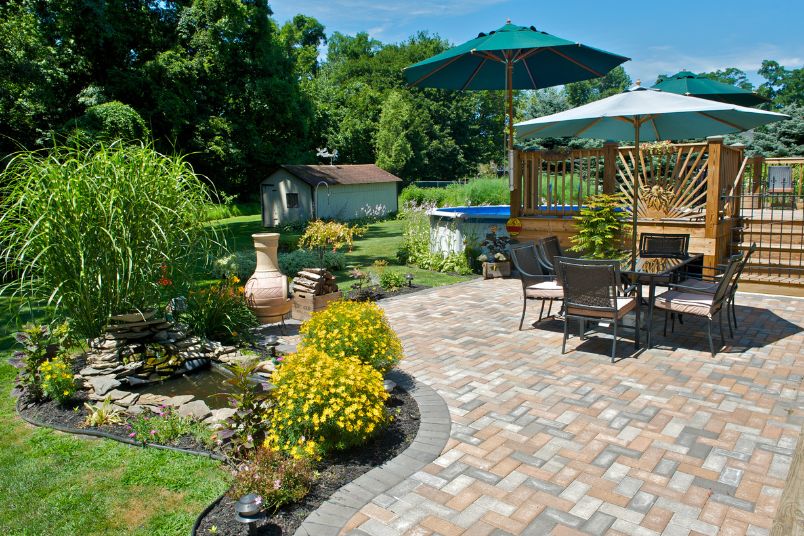
Lawns are one of the most high-maintenance features in any landscape. Not only do they need mowing, watering, and fertilizing, but they provide little benefit to your local ecosystem.
So, for a low-maintenance garden, consider minimizing or replacing your lawn areas with more sustainable options. This can include:
- Ground covers
- Native grasses
- Hardscaping elements, like walkways, pebbles, or patios.
These alternatives require much less maintenance, add visual interest to your garden, and may provide additional habitats for wildlife.
If you must have a lawn, consider choosing a drought-resistant grass variety best-suited to your climate and soil conditions. That way, you’re not fighting nature.
You’ll also want to leave grass clippings on the lawn after you mow to reduce your lawn’s need for water and fertilizer. That way, you’ll have a beautiful green space with much less trouble.
6. Take a Holistic Approach to Pests & Diseases
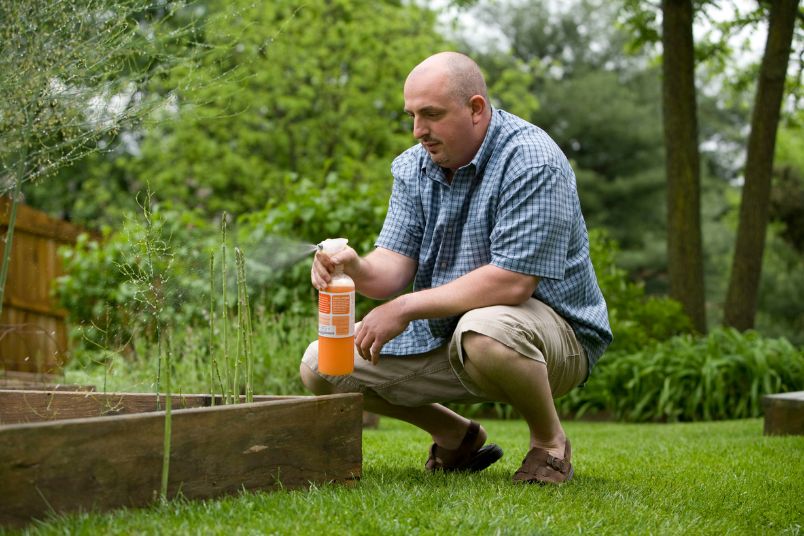
One of the biggest challenges to a low-maintenance garden is dealing with pests and diseases. Traditional gardening methods often involve chemical pesticides, which can harm beneficial insects, pollinators, and even humans.
For a low-maintenance garden, you’ll want to take a more holistic approach.
Integrated Pest Management (IPM) focuses on prevention rather than intervention by using physical, cultural, and biological control measures to manage garden pests.
For example, planting diverse plants can help attract beneficial insects that will prey on garden pests.
Likewise, be sure to remove weeds, debris, and dead plant matter from your gardens to discourage pests and diseases.
Properly spacing your plants helps ensure their health and encourages airflow, reducing the likelihood of fungus, powdery mildew, and other common garden diseases. Choosing disease-resistant varieties helps, too.
Incorporating these practices into your gardening routine can significantly reduce or eliminate the need to use chemical pesticides, and will save you time and effort in managing pests.
7. Design a Garden for Your Lifestyle
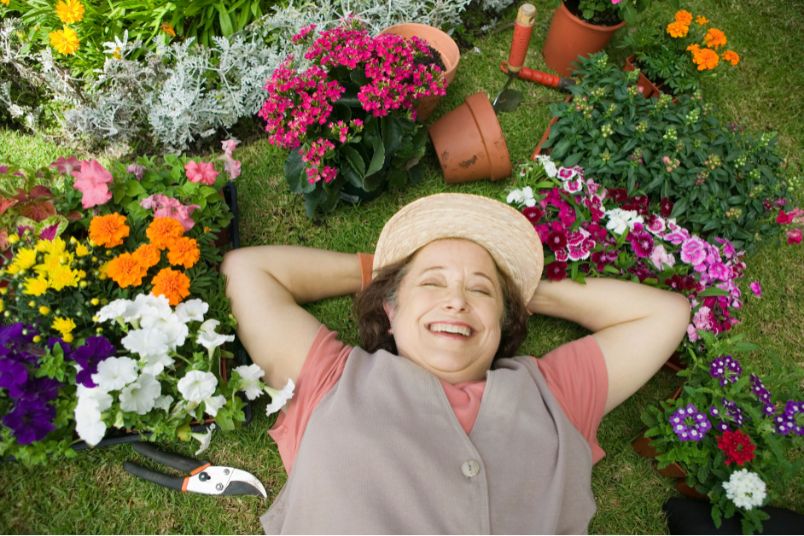
To create a low-maintenance garden, design a space that fits your lifestyle and gardening goals.
You can do this by identifying which garden tasks you enjoy doing or prefer to avoid, along with how much time you have available.
For instance, if you love flowers but don’t want to deal with frequent deadheading, opt for self-cleaning plants that will shed their petals once they are spent.
Similarly, choose low-growing or compact plants that require less pruning if you prefer a neat garden.
Another essential aspect to consider is the layout of your garden. Grouping plants with similar water and maintenance needs will save you time and reduce wasted watering.
Finally, consider the time of year you want to enjoy your garden.
If you spend much of the summer traveling, it’s smart to design your garden with spring- and fall-blooming perennials in mind. Spend the winter away? How about returning home to a beautiful display of spring bulbs in bloom?
Plan your garden so it supports and enhances your lifestyle.
Final Thoughts on Easy Landscape Maintenance Checklist
With this 7-step landscape maintenance checklist, you’re on your way to planning a low-maintenance garden. You can dedicate a small portion of your day to keeping the garden up, and spend more time enjoying a tranquil haven in bloom that’s ready and waiting for you.

About Jackie Gately, editor-IN-CHIEF
I'm Jackie Gately, your travel confidante and the creative force behind Enjoy Travel Life, awarded the "Best Casual-Luxury Lifestyle Blog (USA)" in Travel and Tourism by LUXlife Magazine for four consecutive years. With 25 years of published expertise, I'm a seasoned writer, editor, and photographer curating inspiring travel guides and lifestyle tips for empty nesters. I hope to kindle your spirit of exploration, encouraging you to overcome obstacles and turn your dreams into reality. Learn to minimize your pre-travel angst and maximize the joy of exploration with insights from my experiences. Let's make every adventure a celebration of this exciting phase of life! Follow my social channels for more inspiration.
Next Steps
For more gardening tips, read these articles next:
- How To Use A Natural Gardening Approach Against Pests
- Plant These 28 (Hot!) Drought Resistant Perennials & Plants
- 13 Easy Summer Gardening Tips for a Vibrant Home Garden
- 31 Pet Safe Plant Choices with Pet-Friendly Tips for Your Yard
- Gardening: 10 Beneficial And Harmful Insects You Should Know
- What Are the Best Fall and Winter Plants for the Garden?
- 5 Drought Tolerant Lawn Alternatives For A Better Yard

